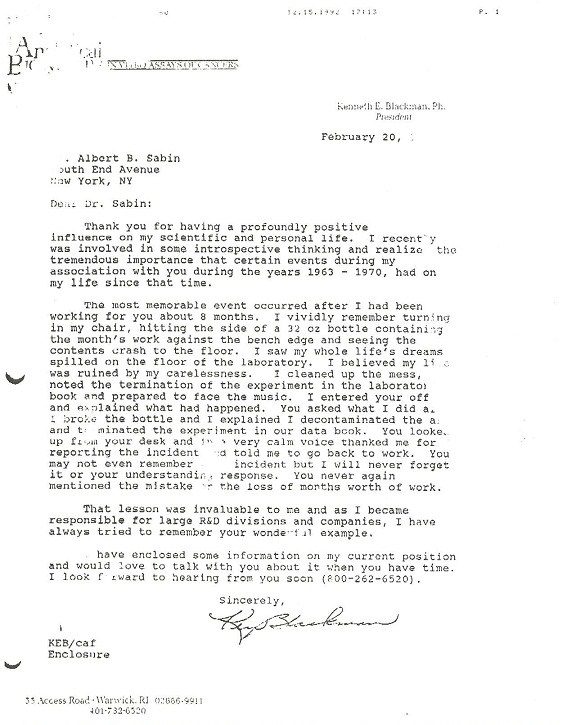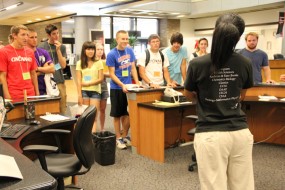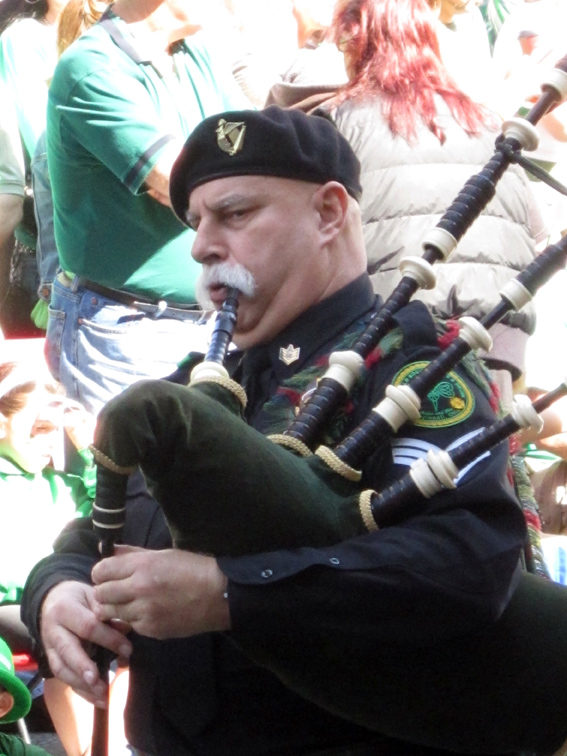 Images
Images
All images used on LiBlog are from stories on the blog- Feel free to browse!

Will the Library be open during the renovation?
Yes. We are temporarily located in the Computer Concourse in Muntz 112K and 112B.
How long will the Library be in its temporary location?
The renovations are expected to be complete in the summer of 2013. We will post an announcement with the official opening date of the new Library in the late spring or early summer of 2013. Continue reading
By Richard Jason Sookoor, Sabin Project Student Assistant

A letter written in 1992 to Dr. Sabin from Dr. Blackman regarding the incident roughly 30 years prior. Their correspondence over the next few months would last until Dr. Sabin's passing in 1993.
Successful people are often described as being driven, strong-willed, or zealous. Though to be definitively admirable, a person should also be compassionate, forgiving, and considerate. Dr. Albert Sabin managed to find a steady balance between these two domains, stern yet soft. In speaking with Dr. Kenneth Blackman, a former assistant to Dr. Sabin, we gain some insight on the level of professionalism and empathy shown by Dr. Sabin.
As the story goes, Dr. Blackman, then a young man with an opportunity to work in Dr. Sabin’s lab, was busy working on a project related to a potential human tumor virus. Dr. Blackman’s duties were to properly identify and collect concentrates in fluid from tissue culture infected with this particular virus. Despite the relatively cramped working space (Old Children’s Research Building R), Dr. Blackman was able to complete this rather standard collection with nary an incident for weeks. On a particular day though, a Friday, things took a heartbreaking turn for the worse. Dr. Blackman, completing the daily collection of concentrates from tissue culture, was steadily handling a bottle containing a few weeks’ worth of sample liquid. Bottle in hand, as he was turning towards away from the tissue culture station, the bottom of the bottle clipped the edge of the work bench causing the contents to fall out. Continue reading
Beginning August 3rd, the UCBA Library Give & Take Exchange Rack will be unavailable during the 2012-2013 academic year due to the renovation project. Continue reading
By Heather Maloney
The UC Blue Ash Library will be closed for relocation from Monday, August 6th through Friday, August 10th. The Library will reopen on Monday, August 13th and will resume Break hours: 12-5pm Monday-Thursday and Fridays from 12-4pm during break. Click here for a full list of Library hours. Continue reading
By: Richard Sookoor, Sabin Student Assistant
While perhaps never considering himself an adventurer, Dr. Sabin was surprisingly well traveled. Considering the span of his career, both military and academic, it might not seem unusual to visit quite so many different countries, though it is remarkable nonetheless.
Though he admits his adoration of living in the US, it seems the desire to travel was well within Dr. Sabin’s nature. Having traveled to at least 32 different countries* in his life, the opportunity to experience so many different cultures and lifestyles appears to have been well exploited. From cities as exotic as Dakar [1] and Bombay (at least in the 1960’s) to more contemporary locales like Stockholm and Paris, Dr. Sabin certainly realized the divergence of a (then) disconnected world. Continue reading
A free trial to BMJ Case Reports until August 31, 2012 at http://casereports.bmj.com! BMJ Case Reports has published more than 2000 peer-reviewed cases making it the world’s largest repository of clinical cases online. The case reports published online cover over 32 specialties and topics.
The free trial to BMJ Case Reports entitles UC users to:
Watch an Overview of BMJ Case Reports
Watch How to Write a Full Text Case Report
Watch How to Submit a Full Text Case Report
Flyer on How to Submit Your Cases to BMJ Case Reports (PDF)
We encourage you to check out BMJ Case Reports, submit your own cases, and let us know if you’d like the library to subscribe to this resource. Please send comments or questions to edith.starbuck@uc.edu
 UC Libraries play an active role in welcoming new students to the University. This summer (through August 2), over 4,000 incoming students participating in UC New Student Orientation are visiting Langsam Library. While here, they engage in activities designed to be entertaining while at the same time informative about the various research resources and services available in the Libraries.
UC Libraries play an active role in welcoming new students to the University. This summer (through August 2), over 4,000 incoming students participating in UC New Student Orientation are visiting Langsam Library. While here, they engage in activities designed to be entertaining while at the same time informative about the various research resources and services available in the Libraries.
One of my favorite letters that I have come across so far during this project is a 1951 letter from Dr. Sabin to his colleague Dr. Harry A. Feldman. In the letter, Dr. Sabin commented on a grant application Dr. Feldman sent to the National Institutes of Health. As usual, Dr. Sabin did not hold back his opinions on what could be done to improve the application. But in his letter, he also urged Dr. Feldman to write his material up for publication. He wrote:
[I]ndicate what it is you want to test, why, how many, where from, etc. If you don’t mind my saying so, Harry, the best way to achieve that is to outline one or more papers for publication and see what data you would like to have rounded out, get that data rounded out, and I will pray to God that ultimately you will write it up for publication. I can only say that I wish you would do what I preach and not what I practice myself. If you don’t write up the work you do over the years, it is work done for your own personal benefit and does not add to the sum total of scientific knowledge.[1] Continue reading
By: Kevin Grace
 Every October, the Society of Ohio Archivists sponsors “Archives Month in Ohio” to encourage teachers, students, scholars and the general public to seek out and learn from the rich historical resources in the state. From the smallest community historical society to the largest public libraries and universities, the wealth of primary research material in Ohio contributes not only to appreciation of our heritage, but provides understanding of our current lives as well.
Every October, the Society of Ohio Archivists sponsors “Archives Month in Ohio” to encourage teachers, students, scholars and the general public to seek out and learn from the rich historical resources in the state. From the smallest community historical society to the largest public libraries and universities, the wealth of primary research material in Ohio contributes not only to appreciation of our heritage, but provides understanding of our current lives as well.
And each year, the SOA Archives Month Committee selects a specific topic to highlight repository holdings. In the past, some of the themes have been music, African American heritage, business, and sports. As part of the annual focus, exhibits, lectures, and other programs are offered and a promotional poster is printed. For 2012, the theme is “Peoples of Ohio” and southwestern Ohio will focus on Irish heritage. For the poster, the Archives & Rare Books Library contributed the image shown here of a piper from the Cincinnati Emerald Society of Police and Fired Pipes and Drums Corps performing in the city’s annual St. Patrick’s Day parade. This photo will accompany other wonderful images representing the state’s Native American, Greek, Slovak, Jewish, German, French, and African American citizens, for example. Posters will be available by late summer. Continue reading